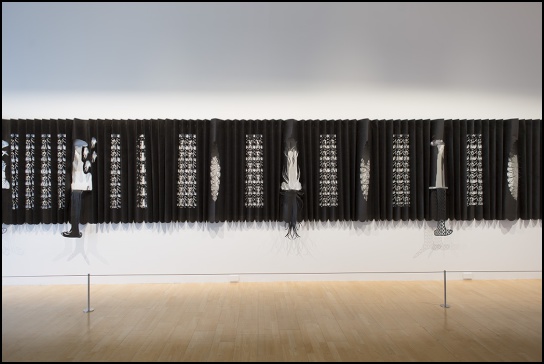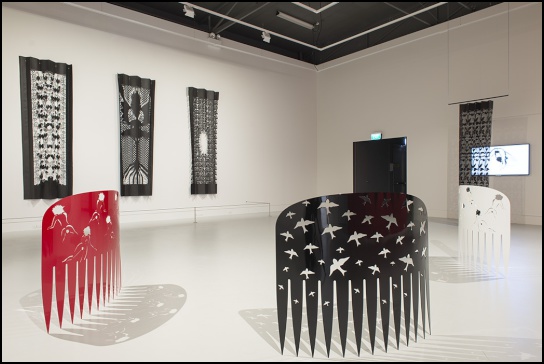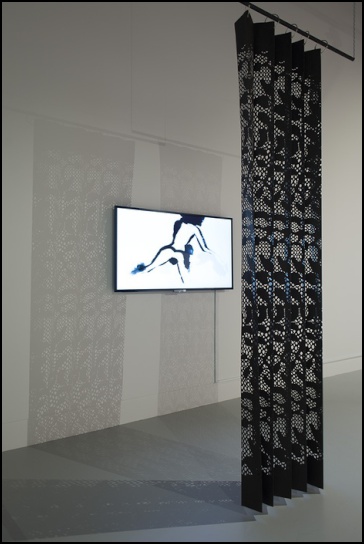‘Black Bird’: Lonnie Hutchinson at
the Dowse
Howard Davis'Black Bird: Lonnie Hutchinson 1997-2013: A Survey' is the first major retrospective of Lonnie Hutchinson's rich and varied practice over seventeen years. Born in 1963, Hutchinson received a Diploma in Textile Printing from AIT in 1992 and a Bachelor of Design from Unitec in 1998. She's worked in a wide range of media, including film, performance, painting, sculpture, and installation art, frequently drawing on feminism, historical narratives, and the traditions of her Māori and Samoan heritage.
In 2002 Hutchinson worked collaboratively as part of the 'Vahine Collective,' researching ancient Samoan rock platforms called tia seu lupe (pigeon-snaring mounds). Over the past decade, she's also created many permanent public installations throughout NZ - including a recently-restored digital binocular station situated in Wellington's Chew's Lane, which presents viewers with images of virtual landscapes, and 'Night/I Love You' installed on the exterior walls of a car park in Manakau in August, 2015. Three years in the making, it consists of two phrases spelled out in large red neon lettering - "I Love You" and "Aroha atu Aroha mai."
Hutchinson is perhaps best known for her sculptural cut-outs made from black builder's paper - a modern, industrial version of tree bark, their multiple lacerations inter-twining with the intricacy of woven baskets. Like Cara Walker's paper silhouettes, Hutchinson's cut-outs reveal a highly-developed sensitivity to female subjectivity. Combined with her cultural heritage, they are uniquely suited to her interest in patterns, the play of light and shadow, and the navigation between space and time: "Intrinsic to each series within my art practice, I honour tribal whakapapa or genealogy. In doing so, I move more freely between the genealogy of past, present and future to produce works that are linked to memories of recent and ancient past ... I make works that talk about those spaces in between, those spiritual spaces."
 Lole
Lole/Waiting for Le Ma’Oma’O, Courtesy of the Dowse
Gallery
Lole
Lole/Waiting for Le Ma’Oma’O, Courtesy of the Dowse
GalleryOriginally mounted at Auckland's Gus Fisher Gallery and curated by Linda Tyler, 'Black Bird' surveys Hutchinson’s career in depth. From video interviews with family members and free-standing sculptures to large-scale paper cut-outs, it provides much to ponder in a relatively small space. As Ane Tonga notes, the recurrent use of these materials addresses "a wide range of historical, social and representational constructs," creating "new methodologies that link colonial and ancestral accounts to … empower indigenous women in their urban existence.” Hutchinson’s work always seems intensely aware of the ground on which it’s standing. Intricate matrices of pattern connote popular and traditional cultural allusions. A predominant theme is the exploitative nature of economic politics between European settlers and Pacific Islanders, constantly probing the mythological and historical relevance of ancestral Pacific traditions in terms of a colonised and colonizing New Zealand.
'Lole Lole' (2003/2015) exudes an apparently innocent, confectionary, and nostalgic atmosphere. A plethora of gelatinous, artificially flavored and multicolored candies moulded in the shape of jet planes creates the image of a single, much larger airplane. This motif of imported foreign foods, loaded with artificial ingredients and low in nutrients, ironically addresses the exchange of consumer products in the Pacific Island market-place. Their bomber squadron shape comments on the damage inflicted by nuclear test fallout (which caused women to give birth to deformed "jelly babies"), while the cruciform arrangement reminds us that missionaries first hooked converts by offering children candies to entice and seduce them. 'Lole Lole' is juxtaposed next to 'Waiting for Le Ma'oma'o' (2012), whose cut-outs suggest matrilineal and labour-intensive craft traditions such as Sāmoan siapo,Tongan tapa, and Cook Island tivaevae (quilting influenced by Victorian folded paper-cutting) whose value is not measured in monetary or production costs, but rather by the love and patience that are put into their construction.
 Waiting for Le
Ma'oma'o', Courtesy of the Dowse Gallery
Waiting for Le
Ma'oma'o', Courtesy of the Dowse Gallery'Comb' (2009) is surrounded by the large cut-outs 'Sista Girl' (2004), 'Milk and Honey' (2012), and the animated video ' (2015). The primary reds, blacks and whites of the three steel combs are chemically clean, their dentation crisply scored and decorated with cut-out stylized images of birds and a naked woman, whose spread-eagled silhouettes suggest a sense of "seeing through" the curvaceous images. They represent ambiguous attempts to control the uncontrollable, to tame the unruly, to style what's "wild." Since ancient times, birds have been considered as prophetic auguries - symbolizing transcendence from the earth-bound, representing freedom and escape, bridging the land and the sky, and facilitating profundity.
 Courtesy of the
Dowse Gallery
Courtesy of the
Dowse GalleryThe series twenty-two delicate ink on paper works entitled 'Pigeon Tarot' (2003) remind us that pigeons have always played important roles both in Maori mythology and as a food source. They are "boobies" - stupid birds whose trusting nature makes them easy prey, while biblical doves connote spiritual peace and denote the literal/littoral appearance of land. The triangular handkerchief/bird/plane shapes of 'Sista Girl' consist of a series of sinister black masks hung against a red wall, redolent of the resilience of Polynesian women, even when veiled for Sunday Mass. But it's also about the hijacking of ancient cultures by missionaries as the veils/masks become funereal and combine with the earlier themes of flight, aerial attack, and bombardment.
The surrounding folded paper pieces present strident black horizontal swathes and vertical falls, rich in their flickering, shifting detail. The middle image of 'Milk and Honey' is of a woman merged with a tree whose roots grow deep into the soil, it's delicate, lacy, frond-like patterns containing a deep cavity at its center evoking a vagina edged with pubic hair. Hutchinson's filigree work creates an intricate shadow-play that invites us into the installation, incising sharp openings within a multiplicity of frames. The reiterated cut-outs of a naked female form meeting flocks of birds are both elegant and barbed; witty and disturbing; vulnerable, yet also erotic.

'She Could Taste Salt On Her Lips, Courtesy of the Dowse Gallery
'She Could Taste Salt On Her Lips' shows a woman on the sea shore being tossed around in the waves (thrown overboard and castaway?), her veiled activities shadowed behind a curtain screen reminiscent of bordellos, seraglios, and harems. Forced or coerced co-habitation invokes issues of submission and repression, the corruption of innocence and natural naivety. The sound of waves lapping the strand merge with the creaking of ship's timbers and a soft, orgasmic moaning. There are many possible interpretation of these sounds and shapes - skirts, capes, and veils possess the delicacy of dresses and the strength of iron grilles, suggesting states of protection, concealment, or refuge. Clever conjunctions turn koru forms into women throwing up their conjoined hands in celebration, as ancestors and friends, the past and present, home and abroad are all woven together. Such lines of connection are the basis of much Polynesian art, from tapa patterns to Maori raft-painting, leavened with a pinch of Western Pop culture.
Hutchinson demands that we make our own connections between issues of gender, culture, and sexual politics in subtle and understated ways, while acknowledging the spiritual heritage of Oceanic folklore. 'Black Bird' is an impressive and complex array of art by a pioneering feminist, who (like Robin White and Fiona Pardington) has helped indigenous women develop a confident and prominent voice in a largely male and Caucasian-dominated art market.
It will remain on
display at the Dowse until November 15.



 Peter Dunne: Dunne's Weekly - Trump's Tariffs Still Pose Risks For New Zealand
Peter Dunne: Dunne's Weekly - Trump's Tariffs Still Pose Risks For New Zealand Keith Rankin: Barbecued Hamburgers And Churchill's Bestie
Keith Rankin: Barbecued Hamburgers And Churchill's Bestie Gordon Campbell: On Why The US Stands To Lose The Tariff Wars
Gordon Campbell: On Why The US Stands To Lose The Tariff Wars Eugene Doyle: Before It’s Too Late - Reimagine New Zealand’s Military Future
Eugene Doyle: Before It’s Too Late - Reimagine New Zealand’s Military Future  Binoy Kampmark: Gender Stunts In Space - Blue Origin’s Female Celebrity Envoys
Binoy Kampmark: Gender Stunts In Space - Blue Origin’s Female Celebrity Envoys Richard S. Ehrlich: A Deadly Earthquake & Chinese Construction
Richard S. Ehrlich: A Deadly Earthquake & Chinese Construction